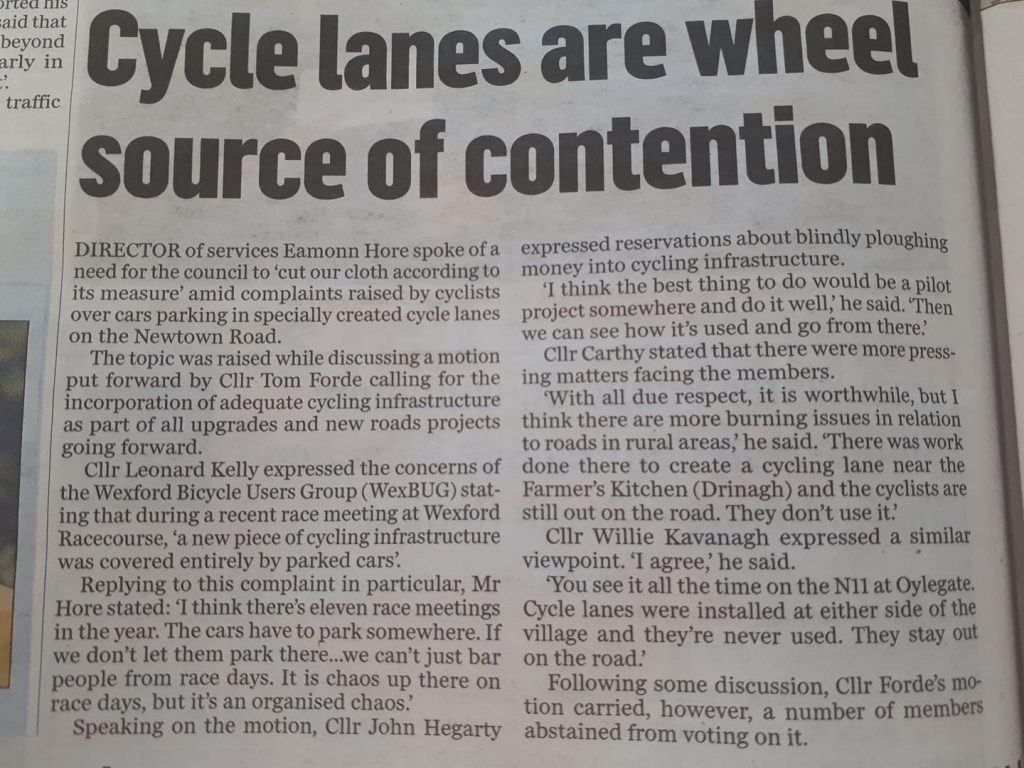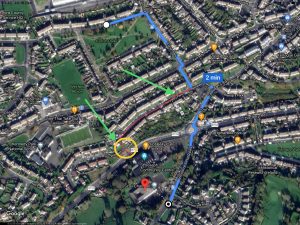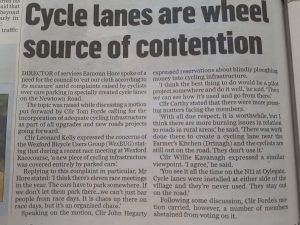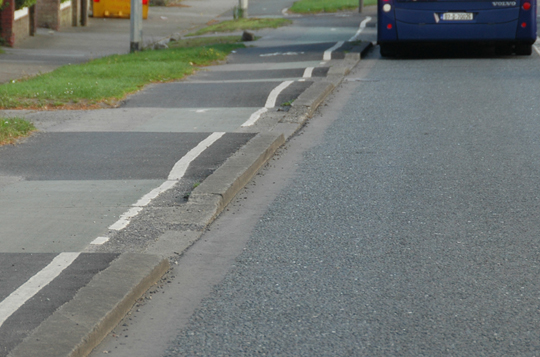
(Image via National Cycle Manual)
For months I had been cycling past the Kilmore Quay link road, in anticipation of the new footpath and cycle lane being fitted at both sides there.
From my fleeting passing view, I could see the footpath being completed and a space left for a cycle path.
I wryly smiled, thinking, ‘this is the one – this is where I finally get to see high quality cycling infrastructure come to our county, that can act as a blueprint for others to follow’.
I so wanted this to be the watershed moment where the promised land of ‘high quality cycling infrastructure’ would be delivered; that this would be designed to at least, National Cycle Manual or the Design Manual for Urban Roads & Streets (DMURS) Standards on what was after all, a greenfield site so excuses of space, etc. would not be an issue.
For reference, this is a link road bypassing Kilmore Quay built mainly for the purpose of allowing HGVs the opportunity to bypass the village and I give credit to the council for including cycling infrastructure in this project.
The main disappointments for me here though are the access and exit points and while these are far from the worst I’ve cycled along, the dishing of the cycle lane at every gateway and access point.
I don’t view this as vital cycling infrastructure as most cyclists will most likely continue through Kilmore Quay Village. (Indeed both signed routes of the EuroVelo1 and the Norman Way rightly take riders into this pretty village).
The design therefore is probably not going to cause much problems on this particular road, but the concern would be for when/if it it was to be replicated in a busier environment.
It’s important to consider that Wexford Co Co now has almost €2,000,000 of dedicated active travel cycling infrastructure in their war chest and my fear is that, if this becomes the blueprint or the norm, then will we waste a vital opportunity to get bang for hard earned tax-payer buck?
Let’s take a closer look.
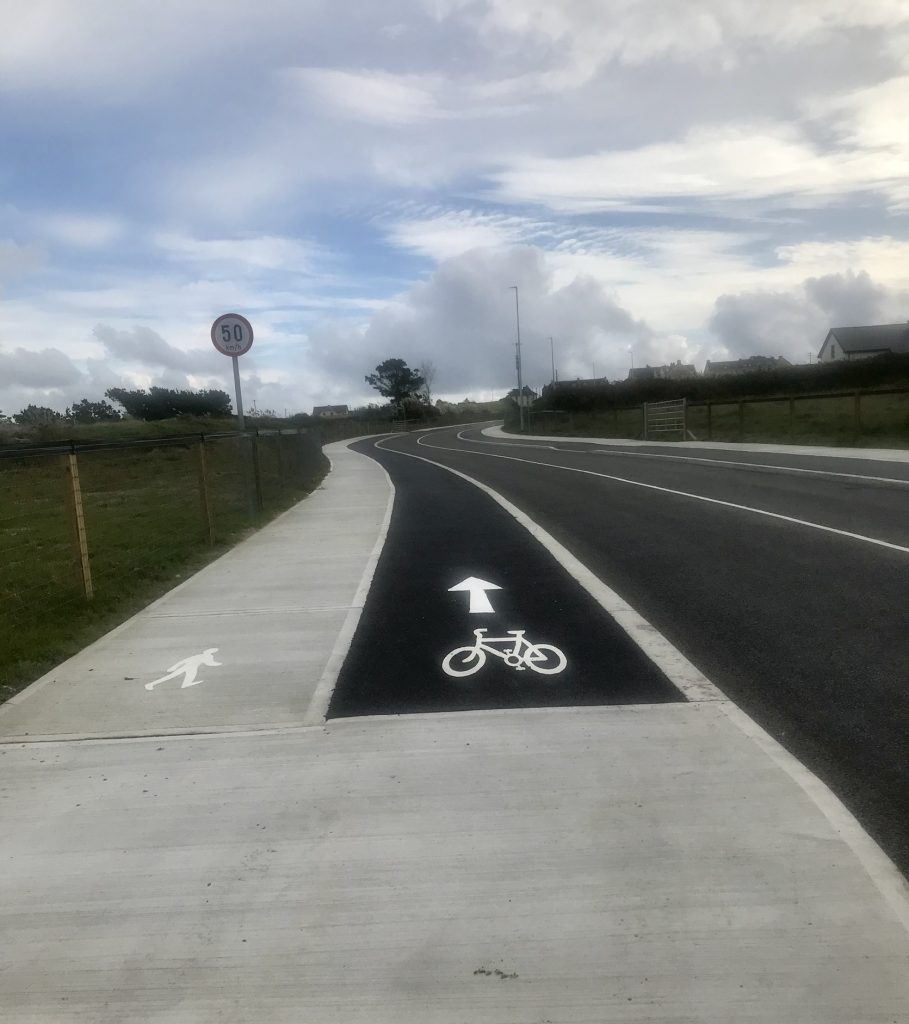
This is replicated at every gateway along the route length.
The segregation of the cycle lane and the footpath here looks really good and I commend Wexford Co Co for not taking the easier option here and make this a shared use zone which according to the National Cycle Manual is ‘disliked’ by pedestrians and cyclists alike.
The surface quality is also excellent so top marks in that regard.
However, in my view, issues lie in how the cycle lane interfaces with the roadway in terms of entry & exit points along with the dishing of the cycle lane at every gateway and entry point along its length.
ENTRY POINT:
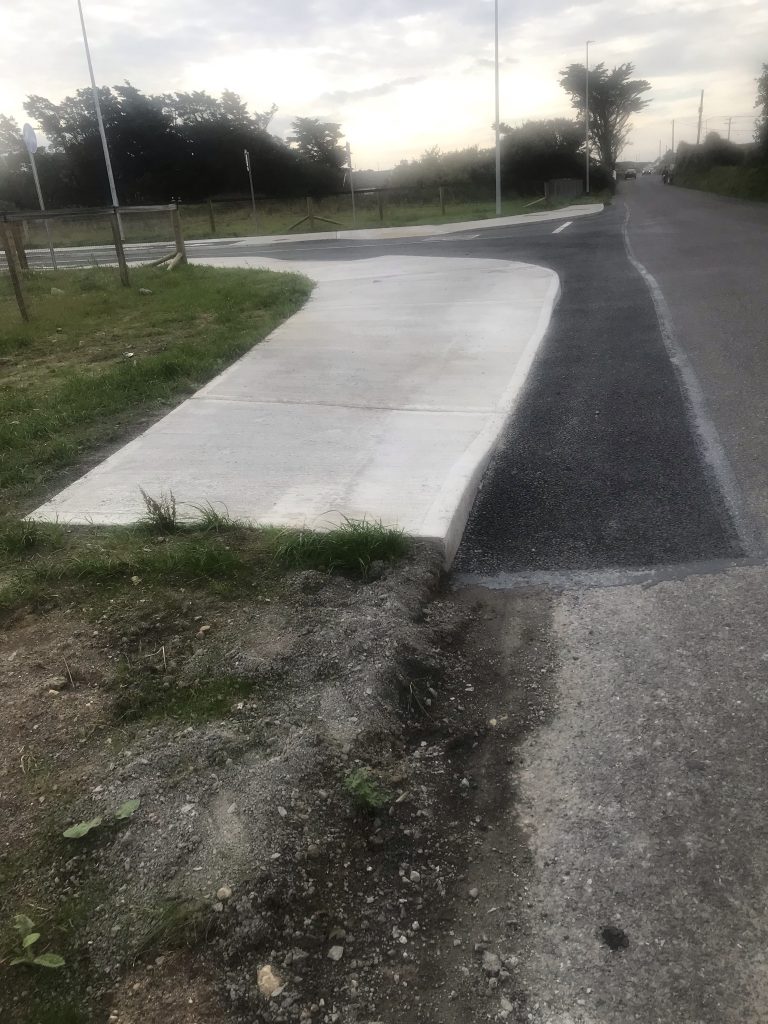
The cycle lane itself is very clearly marked not just with a bike symbol but also it’s done is a darker colour and a different material than the concrete footpath.
On what may seem like a trivial point, in order the access the cycle lane a rider has to cycle on the footpath albeit for a tiny stretch to access it.
Cycling on the footpath is illegal in Ireland but of course dismounting is an option – a Hobson’s choice is you will.
I’m not an engineer but maybe a better option would have been to continue the cycle lane as far as the access ramp. I’m sure there are recommendations from the National Cycle Manual that could have helped in that regard too.
Dishing.
The dishing of the cycle track though is more telling in my view.
The particular dishing here is not as bad as many others I’ve seen, but if we don’t move on from the concept of dishing for future cycle track projects, I think we might see problems in more urban areas with entry and exit points.
Funded projects such as the Beechlawn/Clonard Ave. & the Drinagh cycle lanes might present a less forgiving offering. Anyone who has cycled along the recently completed shared use path on the Newtown Rd. might get an uncomfortable view of what this might look like.
The end user experience for a cyclist cyclist should provide a level smooth ride, but instead when we ignore best practice, we can end up with a cyclist needlessly going on an uncomfortable rollercoaster of up/down ramps.
Below are 2 key points from the National Cycle Manual that relate to dishing and design recommendations to avoid this.
- The footpath and cycle facility should be pulled right across the entrance(s) such that there is no change in vertical alignment of cycle facility.
- Continuous surface materials reinforce the continuity of pedestrian and cyclist priority across the entrance.
The NTA’s National Design Manual covers interfacing of footpaths and cycle tracks between entrances and the main carriageway quite well, so I’m unsure why the designer has gone with dishing here rather than the recommended bituminous ramps or bevelled kerbs as the interface with the main carriageway but what I can say with a fair degree of certainty is that it will put many people off using it.
The image below is the suggested design from the National Cycle Manual which allows cyclists to experience no change in the vertical alignment of the cycle lane whilst providing an interface with the main carriageway via beveling.
This design for the Kilmore Quay link road would have worked for all users I believe.
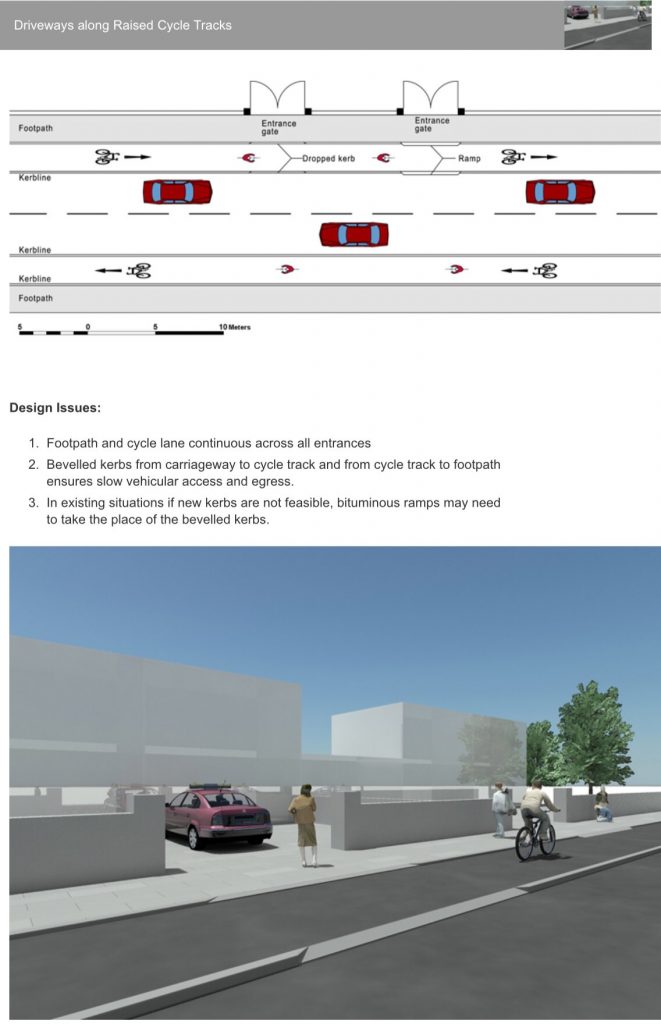
Cyclists do not have to use provided cycling infrastructure.
We have written about this in many previous blogs, that cyclists don’t have to use cycling infrastructure that has been provided; not because ‘they’ feel entitled or any other adjective you can come up with, but because many cycle lanes or shared use areas, are simply dangerous, are full of glass, debris, parked cars etc. or in the case of this one, just uncomfortable to cycle on.
A cyclist is allowed by law to use their discretion and choose themselves.
High Quality is of the upmost importance
Therefore when building cycling infrastructure, high quality is of the upmost importance to entice a rider to use it.
Indeed, the provision of high quality cycling infrastructure was a proposal made by WexBUG member, Cllr. Leonard Kelly at the December 2020 meeting and was unanimously ratified by all county councillors (you can read it here).
One of our National blueprints for high quality cycling infrastructure is the NTA produced, National Cycle Manual so shouldn’t this be our go-to for such infrastructure..?
This, after all has the unanimous support of councillors so why is it being ignored?
Now we understand that the National Cycle Manual isn’t mandatory for councils but you simply can’t have the promise of high quality infrastructure from the NTA, Dept. Transport etc. living side by side with poor design practices especially with so much money being thrown at active travel.
Pertinent questions then rear their heads such as:
- Do Local Authorities such as Wexford Co Co have to give a reason when they decide not to follow the National Cycle Manual?
2. Is there any arbiter who sanctions ignoring the manual?
3. Is there any financial penalty or does the money just arrive in LA’S account anyway?
This all of our hard earned taxpayers’ money we are spending here.
A suggested alternative from Co. Monaghan.
In my view, in order for Wexford Co Co to put our county in the best position to achieve High Quality cycling infrastructure, we need to follow councils that seem progressive in that area.
Monaghan is one such example where a very strong commitment is given to using the key documents (DMURS & National Cycle Manual) is given when introducing cycle infrastructure on its county’s streets.
(You will find the quoted excerpt below this image)
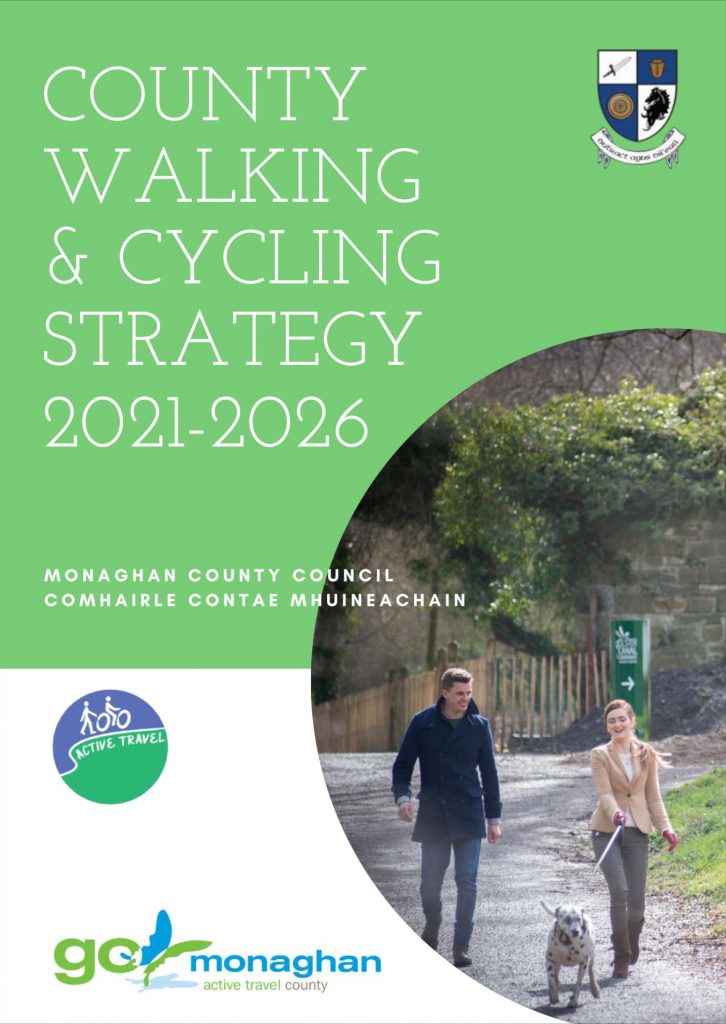
The design manual for urban roads & streets (DMURS) and the National Cycle Manual are the key are the key policy documents which we will be following when we are introducing cycle infrastructure on the roads and streets of Co. Monaghan.
Monaghan walking and cycling strategy document October 2021.
I think if we we continue to ignore best design principles, then we will fail in our attempt to entice more people to cycle and those who are already cycling may continue to use the main carriageway and we know what happens then but it’s with poor design where much of this angst has it origins.
We already been on that hamster wheel and it time to move on…
There is too much at stake now!!
